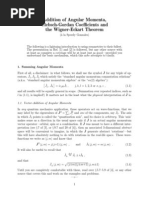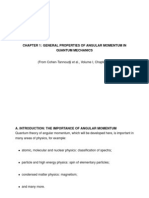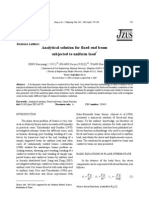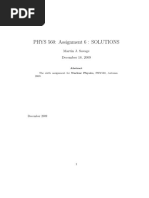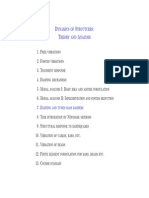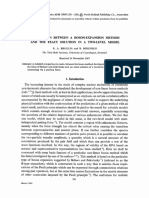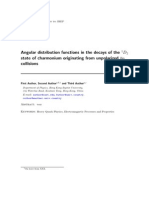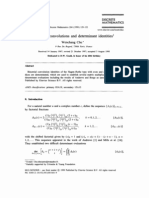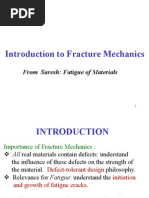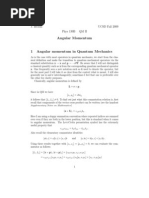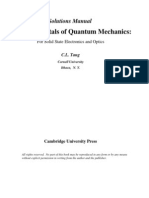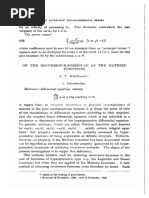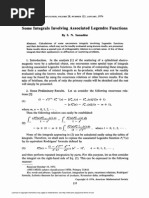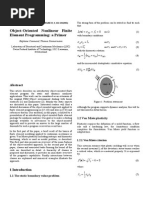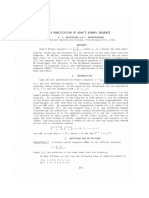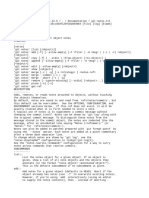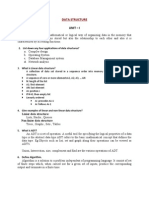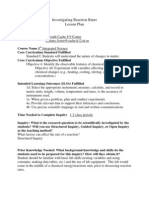Clebsch Gordan Coefficients
Clebsch Gordan Coefficients
Uploaded by
Cu miCopyright:
Available Formats
Clebsch Gordan Coefficients
Clebsch Gordan Coefficients
Uploaded by
Cu miCopyright
Available Formats
Share this document
Did you find this document useful?
Is this content inappropriate?
Copyright:
Available Formats
Clebsch Gordan Coefficients
Clebsch Gordan Coefficients
Uploaded by
Cu miCopyright:
Available Formats
APPENDIX B
CLEBSCH-GORDAN COEFFICIENTS
Clebsch-Gordan coefficients arise when two angular momenta are combined into a
total angular momentum. This will occur when the angular momentum of a system
is found as the combination of the angular momenta of two subsystems or when two
types of angular momenta relating to the same particle are combined to find the total
angular momentum for that particle, as in the addition of orbital and spin angular
momenta to obtain a total angular momentum for the particle.
Let us find the total angular momentum j as a sum of the momenta ji and j
2
. The
wave function for the total momentum can be written as
(JU2, \2 \jm) ip
hmi
ip
hm2
, (B.I)
YYl\ ,TYli
where the indices on the wave functions characterize the angular momentum and its
projection onto a fixed axis. The coefficients in this expansion are called Clebsch-
Gordan coefficients. We now examine their properties.
B.I PROPERTIES OF CLEBSCH-GORDAN COEFFICIENTS
B.I.I Condition for Addition of Angular Momentum Projections
It follows from the conservation law for the sum of angular momentum projections
that
(JiJ2>
m
i
m
2 \J
m
) 0 if
m
\ +
m
2 ^
m
- (B.2 )
Radiative Processes in Atomic Physics. V. P. Krainov, H. R. Reiss, B. M. Smirnov 235
Copyright 1997 by John Wiley & Sons, Inc.
ISBN: 0-471-12533-4
2 36 CLEBSCH-GORDAN COEFFICIENTS
B.1.2 Orthogonality Condition
Orthogonality properties of the wave functions are expressed as
This leads to the orthogonality condition for the Clebsch-Gordan coefficients, which
is
2_] Oi72 , m\m
2
\jm) (j\j
2
, m\m
2
jm
f
) = 8
mm
>, (B.3)
where 8
mm
> is the Kronecker delta symbol defined by
1, m m
1
0, mi- m
1
B.1.3 Inversion Property
In the inversion transformation of the radius vector, r > r, the wave functions will
change sign or not, depending on their parity. That is, the wave functions transform
as
\\r.
v
(i \i~
m
\\r .
This leads to
so that we obtain
O"i7*2 , -m
h
-m
2
\j, ~m) = (-l)
J
~
Jl
~
j2
(jiJ2,m\m
2
\jm). (B.4)
B.1.4 Permutation Properties
It follows from the rules for the construction of the Clebsch-Gordan coefficients and
the rules for the addition of two angular momenta into a zero total angular momentum
that
{j\h,m
x
m
2
\jm) = (-l)
Jl m
'
x
j(j
l
j
f
m
lt
~m\j
2
- m
2
) (B.5)
72 , m, m
2
\j\ mi).
EVALUATION OF CERTAIN CLEBSCH-GORDAN COEFFICIENTS 2 37
B.2 EVALUATION OF CERTAIN CLEBSCH-GORDAN
COEFFICIENTS
We consider first the evaluation of Clebsch-Gordan coefficients for the frequently
occurring case h ~ \- We begin by obtaining a relation for Clebsch-Gordan coef-
ficients that is valid for any angular momenta. From the addition properties used to
form j = ji + J2, we obtain the condition
j
2
~ ji ~ J2 = 2 ji j
2
= 2j
u
J2z + 7*1 + 72 - + 71-7*2 +.
When this operator acts on the wave function in Eq. (B.I), the result is
JU + 1) ~ 7i0*1 + 1) ~ 72 (72 + 1) = y^0'i72 > raim
2
17m) p!72 , m[m'
2
\jm)
X
{^hm^hm^hzhz + 7*1 + 7*2-
+ 7*1-7*2+ l^,m>;
2
m
2
).
For the given value of m, the conservation rule for angular momentum projections
gives
m\ = m 1712, m[ = m m
2
.
With the help of the momentum operator eigenvalues in Eqs. (A.2 ) and (A.9), we find
that
7(7 + D- 7i ( 7i + l ) - 72 (72 + D
m
2
- mQQ'i + mi + \)(j
2
- m
2
+ l)(j
2
+ rn
2
)
m
2
x
{j\J2,m
x
m
2
\jm)(jiJ2,mi + 1, m
2
- l\jm)
^ 7
2
- m
2
)(j
2
+ m
2
+ 1)
m
2
x
O'i7*2 , rn
x
m
2
\jm){jxJ2y mi - 1, m
2
+ \\jm). (B.6)
Now we apply the above results to the particular case where j
2
= \. For the given
values 7, 7i, there are two nonzero Clebsch-Gordan coefficients that we shall denote
as
X={h\,m-\,\\jm),
2 38
CLEBSCH-GORDAN COEFFICIENTS
Using this notation, Eq. (B.6) for j
2
= \ becomes
JU + 1) " 7i O'l + 1) " I = (m - \)X
2
- [m + i ) Y
The normalization condition for the Clebsch-Gordan coefficients given in Eq. (B.3)
is of the form
X
2
+ Y
2
= 1.
When this is inserted into the preceding expression, we obtain
U - h)U + h + 1) - 3 = m (X
2
- Y
2
) + 2\l(j
x
+ | )
2
- m*XY.
With the notation
we can rewrite our results as the system of equations
t(X
2
- Y
2
) + 2 \ / l f-XY = 1, X
2
+ Y
2
= \.
The ambiguous sign is such that the upper sign corresponds to j = j \ + \, while
the lower sign is associated with j = j
x
\.
The solution of the equations we have obtained is
for 7 = 7i + 5, and for j
=
j \ ~ \ it is
These results are summarized in Table B.I.
TABLE B.I. ( j \ \, m - <r, o-1 jm)
j - h
1
2
1
2
I
2
j ji + m +
V
2
h + 1
[h-m +
V V x +1
i
2
1
2
cr
_ l
2
>
V 2 y , +
/ .
( + m
i /
+" \
1
+ i
EVALUATION OF CERTAIN CLEBSCH-GORDAN COEFFICIENTS 2 39
Other values for Clebsch-Gordan coefficients are generally more complicated to
express. Thorough treatments of the relations between Clebsch-Gordan coefficients
and tables of values are available in the literature. See, for example, Refs. 9 or 10.
Another relatively simple form taken by the Clebsch-Gordan coefficients occurs
when the projection of the angular momentum coincides with this momentum. In that
case we have
0
. . . . . v O/'i +m
2
,m
\j2,J\m
2
\jm) = y/U\ +72
C/2 ~ W2 )! (7 + m)\ (2j + 1) (2 71)! (7 71 + 72 )!
C/2 + m
2
)l (j ~ m)\ (7! - 7
2
+ 7)! (7, + j
2
- 7) ! '
(B.7)
V(7i +72 + 7
x
/(7i " mi)! (j + m)\ (2j + 1) (2j
2
)\ (Ji ~ h + 7)!
{]\j2,m
xj2
\jm) =
(7i + m
x
)\ (j - m)\ (j - j , + j
2
)\ (Ji + 72 ~ 7)!'
(B.8)
<7i72 , "71^2 \M) = (-l)
j]+h
~
j
(JU2, 7i " m
2
\j - m), (B.9)
<7i72 , mi - j
2
\jm) - {-\)^h~j^
{jxh
-
m[h
y _
m
y
( E U 0
)
Values of the Clebsch-Gordan coefficients are given in Table B.2 for the case
j
2
= 1. If m
2
= 1 or - 1 , then the coefficients can be calculated using the connections
in Eqs. (B.9) and (B.10). The third possibility, m
2
= 0, can be calculated using the
values obtained for m
2
= 1 and 1, and the normalization condition (B.3) for the
Clebsch-Gordan coefficients.
TABLE B.2. (jil; m - m
2
, m
2
I jm)
7 - 7 i 1
m
2
,KjL-~*-~,x ji--m) /(7i - m + 1) (7! + m + 1) /(71 - i
(2 7! + 2 ) (2 7! + 1) V (
2
7i + 1) (7i + 1 ) V (
2
7i +
2
) (2 7, + 1)
/(7i m + 1) (7i + m) m
U i
27,(7i
2
lUi-m+V Ui-m) _ /O' i-m)Oi+w). /(71 + m + 1)0"i + ^)
2 7i (2 7i + D V h (2 7i + D V 2 7, (2 7, + 1)
240 CLEBSCH-GORDAN COEFFICIENTS
B.3 WIGNER 3j SYMBOLS
A quantity closely related to the Clebsch-Gordan coefficient is the Wigner 3 7 coef-
ficient, designed to achieve maximum symmetry. It can be defined as
^ ) = (-l)
j]
~
J2
~
m3
(JiJ2>mim
2
\j
3
, -m
3
). (B.ll)
The 3 7 symbol has the property that
= 0 if mi + m
2
+ m
3
= 0,
m
x
m
2
- \ i i >
in place of Eq. (B.2 ).
We list the principal symmetry and orthogonality properties. Even permutation of
the columns leaves the 3j symbol unchanged, or
7i h h \
=
(h h h\ = ( h h h
mi m
2
m
3
I V m
2
m-x nt\ J V m
3
mi m
2
Odd permutation of the columns, on the other hand, is equivalent to multiplication
by( - i y
i + 7 2 + j 3
, s ot hat
7i h h \
=
(h h h
mi m
2
m
3
J \m
2
mi m
3
=
( h h h \
=
I h h J\
\ mi m
3
m
2
I \ m
3
m
2
mi
Orthogonality properties of the Wigner 3j symbols are
h h h \ (J\ h h \ _ o cj
I mi m
2
m
3
J \m[ m'
2
m
3
h h h \ ( h h ^ \
=
hjfnvnjSUUlh)
mi m
2
m
3
J \mi m
2
m\ j 2 /^ + 1
where 8 (jij
2
j
3
) in Eq. (B.12 ) is a quantity defined as
8 (71/2/3) = { I
[f
[
jl
".
hl
~
h
-
h + h
10 otherwise
The statement in Eq. (B.13) is called the triangular condition.
You might also like
- Nikolas Rose Governing The Soul The Shaping of The Private Self 1999Document353 pagesNikolas Rose Governing The Soul The Shaping of The Private Self 1999Sara Beretta100% (23)
- Supply Chain ManagementDocument17 pagesSupply Chain ManagementAjakumbi Ajax Baba100% (1)
- 1992 - (Smirnov) The Clebsch-Gordan Coefficients For The Two-Parameter Quantum Quantum Algebra SUp, Q (2) in The Lowdin-Shapiro ApproachDocument15 pages1992 - (Smirnov) The Clebsch-Gordan Coefficients For The Two-Parameter Quantum Quantum Algebra SUp, Q (2) in The Lowdin-Shapiro Approachfaudzi5505No ratings yet
- Solutions Manual: VibrationsDocument19 pagesSolutions Manual: VibrationsanleNo ratings yet
- Addition of Angular Momenta, Clebsch-Gordan Coefficients and The Wigner-Eckart TheoremDocument8 pagesAddition of Angular Momenta, Clebsch-Gordan Coefficients and The Wigner-Eckart TheoremnewtonfeynNo ratings yet
- A Simple Method For Calculating Clebsch-Gordan CoefficientsDocument11 pagesA Simple Method For Calculating Clebsch-Gordan CoefficientsAna Maria Rodriguez VeraNo ratings yet
- 2003D16Document6 pages2003D16htopaven4340No ratings yet
- Homework 10Document7 pagesHomework 10Alejandro EspinosaNo ratings yet
- Generating Functions For Bessel FunctionsDocument8 pagesGenerating Functions For Bessel FunctionsEnitz SosaNo ratings yet
- Chapter 1: General Properties of Angular Momentum in Quantum MechanicsDocument102 pagesChapter 1: General Properties of Angular Momentum in Quantum MechanicsATP_101No ratings yet
- Analytical Solution For Fixed-End Beam Subjected To Uniform LoadDocument5 pagesAnalytical Solution For Fixed-End Beam Subjected To Uniform Loadtalal2124100% (1)
- Efficient Calculation of Clebsch-Gordan CoefficientsDocument5 pagesEfficient Calculation of Clebsch-Gordan CoefficientsweylguyNo ratings yet
- PHYS 560: Assignment 6: SOLUTIONS: Martin J. Savage December 18, 2009Document8 pagesPHYS 560: Assignment 6: SOLUTIONS: Martin J. Savage December 18, 2009amallia nadhiaratnaNo ratings yet
- Pisano (2012) - ArtigoDocument10 pagesPisano (2012) - ArtigoLucas Meira SantosNo ratings yet
- Problema Dinamica 41Document3 pagesProblema Dinamica 41Cipar ClauNo ratings yet
- Dynamics of Structures: Theory and Analysis: Damping and Tuned Mass DampersDocument19 pagesDynamics of Structures: Theory and Analysis: Damping and Tuned Mass DampersMa RcoNo ratings yet
- 20230620161404 b54eb940 6328 (科研通 ablesci.com)Document1 page20230620161404 b54eb940 6328 (科研通 ablesci.com)王逍No ratings yet
- Goldstein 2nd Edition 2nd Chapter SolutionsDocument10 pagesGoldstein 2nd Edition 2nd Chapter SolutionsKarmakarışıkblog Blogspot67% (3)
- 4t6cn Tw9abDocument9 pages4t6cn Tw9abMohsin MuhammadNo ratings yet
- PJM 13 (1) 2024 220 To 231Document12 pagesPJM 13 (1) 2024 220 To 231divine.ekekeNo ratings yet
- Analysis of Laterally Loaded PileDocument16 pagesAnalysis of Laterally Loaded PileNicola Tomasi100% (1)
- Answers and Solutions: WC! Ibc! - Icei lAC! Iec! lAC! - lAC! - IBC!Document74 pagesAnswers and Solutions: WC! Ibc! - Icei lAC! Iec! lAC! - lAC! - IBC!Jay-Ann SampsonNo ratings yet
- Nuclear Physics North-Hollandpublishing Co., Amsterdam: AbstractDocument16 pagesNuclear Physics North-Hollandpublishing Co., Amsterdam: Abstractarturo_C_MNo ratings yet
- Angular Distribution Functions in The Decays of The D State of Charmonium Originating From Unpolarized PP CollisionsDocument8 pagesAngular Distribution Functions in The Decays of The D State of Charmonium Originating From Unpolarized PP CollisionsEsther SimpsonNo ratings yet
- (6ij+ (C+I+J) ) - Fiat (C) : Binomial Convolutions and Determinant Identities 1Document25 pages(6ij+ (C+I+J) ) - Fiat (C) : Binomial Convolutions and Determinant Identities 1verdosNo ratings yet
- Bessel FunctionsDocument4 pagesBessel FunctionsPraveen KumarNo ratings yet
- Test 1Document6 pagesTest 1sassNo ratings yet
- Coupled LinesDocument10 pagesCoupled LinesFatih TokgözNo ratings yet
- Introduction To Fracture Mechanics Introduction To Fracture MechanicsDocument56 pagesIntroduction To Fracture Mechanics Introduction To Fracture MechanicsShiba Narayan SahuNo ratings yet
- Mechanical Design ElementsDocument6 pagesMechanical Design ElementsFlorian Ion PetrescuNo ratings yet
- Efficient Computation of Clebsch-Gordan Coefficients: 1 1 1 1 K K K K 1 2 1 2 1 2Document5 pagesEfficient Computation of Clebsch-Gordan Coefficients: 1 1 1 1 K K K K 1 2 1 2 1 2SUBHAJIT DUTTANo ratings yet
- SIF For Cracks in Notched Plates in Biaxial LoadingDocument24 pagesSIF For Cracks in Notched Plates in Biaxial LoadingArun KumarNo ratings yet
- 13 - Representations of The Angular Momentum Operators and Rotations PDFDocument17 pages13 - Representations of The Angular Momentum Operators and Rotations PDFUltrazordNo ratings yet
- Method of Integro-Differential Relations in Linear ElasticityDocument12 pagesMethod of Integro-Differential Relations in Linear Elasticitykogax20258No ratings yet
- Homework 9Document7 pagesHomework 9Alejandro EspinosaNo ratings yet
- Angular Momentum: J. Broida UCSD Fall 2009 Phys 130B QM IiDocument45 pagesAngular Momentum: J. Broida UCSD Fall 2009 Phys 130B QM IiWilant GomariNo ratings yet
- Ann ExecDocument7 pagesAnn ExecAnouarNo ratings yet
- International Journal Eng Science 1966 n1 Str53 68Document17 pagesInternational Journal Eng Science 1966 n1 Str53 68Rodolfo Sergio Cruz FuentesNo ratings yet
- Module 9: The Method of Green's FunctionsDocument6 pagesModule 9: The Method of Green's FunctionsprateekbaldwaNo ratings yet
- Solutions The: To ProblemsDocument1 pageSolutions The: To ProblemsKamleshkekane1No ratings yet
- Wave-Vector Diagrams For Two-Dimensional Photonic CrystalsDocument9 pagesWave-Vector Diagrams For Two-Dimensional Photonic CrystalsNguyen Sy Thanh SonNo ratings yet
- (Tang C.) Solutions Manual. Fundamentals of OrgDocument65 pages(Tang C.) Solutions Manual. Fundamentals of OrgMehdi Torabi GoodarziNo ratings yet
- CHARLES B. MORREY-PartialRegularityResults-1968Document23 pagesCHARLES B. MORREY-PartialRegularityResults-1968stefano63.funesNo ratings yet
- On Some Basic Frequency Effects Within The Ab - (2,2) Linear Viscoelastic Solid - Like Behaviour. I. Strain-Controlled Rheodynamic ProcessesDocument8 pagesOn Some Basic Frequency Effects Within The Ab - (2,2) Linear Viscoelastic Solid - Like Behaviour. I. Strain-Controlled Rheodynamic Processeshtopaven4340No ratings yet
- Notes 21oct09 PDFDocument12 pagesNotes 21oct09 PDFSagarNo ratings yet
- Journal of London Math Soc - April 1929 - Whittaker - On The Recurrence Formulae of The Mathieu FunctionsDocument9 pagesJournal of London Math Soc - April 1929 - Whittaker - On The Recurrence Formulae of The Mathieu FunctionsAlba García RuizNo ratings yet
- Statistical Mechanics of Anyons: CompleteDocument17 pagesStatistical Mechanics of Anyons: CompleteLeôncioNo ratings yet
- HES5310 Machine Dynamics 2, Semester 1, 2012, Assignment 2Document57 pagesHES5310 Machine Dynamics 2, Semester 1, 2012, Assignment 2StephenPYBong100% (1)
- Some Integrals Involving Associated Legendre FunctionsDocument7 pagesSome Integrals Involving Associated Legendre FunctionskdsjkfjdlskjvlsdkNo ratings yet
- Mechanics of Solids Week 8 LecturesDocument17 pagesMechanics of Solids Week 8 LecturesFlynn GouldNo ratings yet
- Electronic and Band Structure Slater BlochlDocument29 pagesElectronic and Band Structure Slater BlochlKorir Kiptiemoi KipronohNo ratings yet
- Mindlin Eshel 1968Document16 pagesMindlin Eshel 1968Don't BeCuriousNo ratings yet
- TIPT2Document9 pagesTIPT2cuongspvl2713No ratings yet
- Object-Oriented Nonlinear Finite Element Programming: A PrimerDocument17 pagesObject-Oriented Nonlinear Finite Element Programming: A PrimerBosslucianNo ratings yet
- Quantum Mechanics - Homework Assignment 3: Alejandro G Omez Espinosa October 8, 2012Document7 pagesQuantum Mechanics - Homework Assignment 3: Alejandro G Omez Espinosa October 8, 2012Alejandro EspinosaNo ratings yet
- The Clehsch-Gordan CoefficientsDocument6 pagesThe Clehsch-Gordan CoefficientsCu miNo ratings yet
- Dual Integral EquationsDocument9 pagesDual Integral EquationsahsbonNo ratings yet
- Adikesavan A Modification of Goka's Binary SequenceDocument9 pagesAdikesavan A Modification of Goka's Binary SequenceCeiba GrooveNo ratings yet
- Student Solutions Manual to Accompany Economic Dynamics in Discrete Time, second editionFrom EverandStudent Solutions Manual to Accompany Economic Dynamics in Discrete Time, second editionRating: 4.5 out of 5 stars4.5/5 (2)
- Loose Parts Leason PlanDocument2 pagesLoose Parts Leason Plandmfitch78100% (4)
- Hidro EchosounderDocument6 pagesHidro EchosounderNadi FatikhaNo ratings yet
- Heat ExchangerDocument29 pagesHeat Exchangerrodel rentaNo ratings yet
- Journal of Social and Personal Relationships-1990-Bartholomew-147-781Document33 pagesJournal of Social and Personal Relationships-1990-Bartholomew-147-781FajarRizkiNo ratings yet
- GeneralNatural and Special RevelationDocument2 pagesGeneralNatural and Special RevelationNinguem SabeNo ratings yet
- Section 504 PlanDocument2 pagesSection 504 Planapi-345949595No ratings yet
- Sample Boq of FF WorkDocument115 pagesSample Boq of FF WorkZAHID IQBALNo ratings yet
- DCA Vantage Brochure PDFDocument4 pagesDCA Vantage Brochure PDFmoutasim mohammadNo ratings yet
- DTMDocument215 pagesDTMAnthony D PapousekNo ratings yet
- Coconut CakeDocument2 pagesCoconut CakeNabeelNo ratings yet
- Huawei Optical Network Maintenance Reference-WDM ASON-20140826-CDocument116 pagesHuawei Optical Network Maintenance Reference-WDM ASON-20140826-CSam Awi100% (1)
- CETOP500 2012 EngDocument104 pagesCETOP500 2012 Engtawhide_islamicNo ratings yet
- Text 1Document6 pagesText 1danokidanoki9No ratings yet
- Financial Planning-Guide MEDDocument12 pagesFinancial Planning-Guide MEDAbbeshy MartinNo ratings yet
- Basics of Stock Market Trading GuideDocument10 pagesBasics of Stock Market Trading Guidegokul kNo ratings yet
- Closing Rank After Round IIIDocument11 pagesClosing Rank After Round IIICHANDRA BHUSHANNo ratings yet
- Homework 1 Pavement DesignDocument3 pagesHomework 1 Pavement DesignNoor KhresatNo ratings yet
- Integrity: DR - Hira Jahangir Lecture# 04Document47 pagesIntegrity: DR - Hira Jahangir Lecture# 04saffa saleemNo ratings yet
- Fujica Ax-1Document45 pagesFujica Ax-1Bernardo Varela GrandaNo ratings yet
- Air-Main Charging Systems: DHS 4.0 Series Compact Assistants That Make A Big DifferenceDocument12 pagesAir-Main Charging Systems: DHS 4.0 Series Compact Assistants That Make A Big DifferenceandreaNo ratings yet
- SLSEA Registration Form Sri LankaDocument8 pagesSLSEA Registration Form Sri Lankaවිනෝජ් චමිල්ක ලියනආරච්චිNo ratings yet
- Kavi Jayadev By: Tanisha DasDocument10 pagesKavi Jayadev By: Tanisha DasTanisha DasNo ratings yet
- DS UNIT-I 2 MarksDocument5 pagesDS UNIT-I 2 MarksNiran JanaNo ratings yet
- Investigating Reaction RatesDocument5 pagesInvestigating Reaction RatesAgus SalimNo ratings yet
- Red Hat Enterprise Linux-8-8.4 Release Notes-En-USDocument160 pagesRed Hat Enterprise Linux-8-8.4 Release Notes-En-USAnoopriyaNo ratings yet
- Hobbing 0406Document6 pagesHobbing 0406feni4kaNo ratings yet
- Obedience To God Through The Power of The Holy SPIRITDocument4 pagesObedience To God Through The Power of The Holy SPIRITJennifer Gapuz GalletaNo ratings yet
- Persian Civilization: A Forgotten Empire of Glory Well Deserved To Be RememberedDocument31 pagesPersian Civilization: A Forgotten Empire of Glory Well Deserved To Be RememberedAnonymous HumanNo ratings yet




